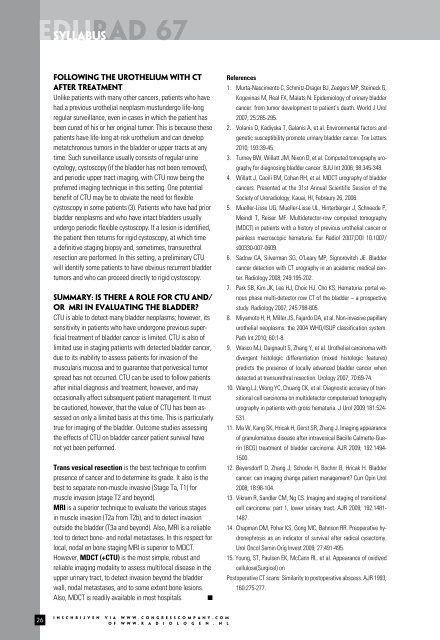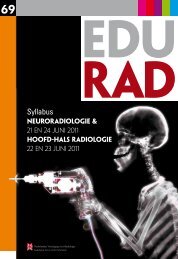You also want an ePaper? Increase the reach of your titles
YUMPU automatically turns print PDFs into web optimized ePapers that Google loves.
eduRAD syllabus 67FOLLOWING THE UROTHELIUM WITH CTAFTER TREATMENTUnlike patients with many other cancers, patients who havehad a previous urothelial neoplasm mustundergo life-longregular surveillance, even in cases in which the patient hasbeen cured of his or her original tumor. This is because thesepatients have life-long at-risk urothelium and can developmetatchronous tumors in the bladder or upper tracts at anytime. Such surveillance usually consists of regular urinecytology, cystoscopy (if the bladder has not been removed),and periodic upper tract imaging, with CTU now being thepreferred imaging technique in this setting. One potentialbenefit of CTU may be to obviate the need for flexiblecystoscopy in some patients (3). Patients who have had priorbladder neoplasms and who have intact bladders usuallyundergo periodic flexible cystoscopy. If a lesion is identified,the patient then returns for rigid cystoscopy, at which timea definitive staging biopsy and, sometimes, transurethralresection are performed. In this setting, a preliminary CTUwill identify some patients to have obvious recurrent bladdertumors and who can proceed directly to rigid cystoscopy.SUMMARY: IS THERE A ROLE FOR CTU AND/OR MRI IN EVALUATING THE BLADDER?CTU is able to detect many bladder neoplasms; however, itssensitivity in patients who have undergone previous superficialtreatment of bladder cancer is limited. CTU is also oflimited use in staging patients with detected bladder cancer,due to its inability to assess patients for invasion of themuscularis mucosa and to guarantee that perivesical tumorspread has not occurred. CTU can be used to follow patientsafter initial diagnosis and treatment, however, and mayoccasionally affect subsequent patient management. It mustbe cautioned, however, that the value of CTU has been assessedon only a limited basis at this time. This is particularlytrue for imaging of the bladder. Outcome studies assessingthe effects of CTU on bladder cancer patient survival havenot yet been performed.Trans vesical resection is the best technique to confirmpresence of cancer and to determine its grade. It also is thebest to separate non-muscle invasive (Stage Ta, T1) formuscle invasion (stage T2 and beyond).MRI is a superior technique to evaluate the various stagesin muscle invasion (T2a from T2b), and to detect invasionoutside the bladder (T3a and beyond). Also, MRI is a reliabletool to detect bone- and nodal metastases. In this respect forlocal, nodal en bone staging MRI is superior to MDCT.However, MDCT (+CTU) is the most simple, robust andreliable imaging modality to assess multifocal disease in theupper urinary tract, to detect invasion beyond the bladderwall, nodal metastases, and to some extent bone lesions.Also, MDCT is readily available in most hospitals. nReferences1. Murta-Nascimento C, Schmitz-Drager BJ, Zeegers MP, Steineck G,Kogevinas M, Real FX, Malats N. Epidemiology of urinary bladdercancer: from tumor development to patient’s death. World J Urol2007; 25:285-295.2. Volanis D, Kadiyska T, Galanis A, et al. Environmental factors andgenetic susceptibility promote urinary bladder cancer. Tox Letters2010; 193:39-45.3. Turney BW, Willatt JM, Nixon D, et al. Computed tomography urographyfor diagnosing bladder cancer. BJU Int 2006; 98:345-348.4. Willatt J, Caoili EM, Cohan RH, et al. MDCT urography of bladdercancers. Presented at the 31st Annual Scientific Session of theSociety of Uroradiology, Kauai, HI, Febraury 26, 2006.5. Mueller-Lisse UG, Mueller-Lisse UL, Hinterberger J, Schneede P,Meindl T, Reiser MF. Multidetector-row computed tomography(MDCT) in patients with a history of previous urothelial cancer orpainless macroscopic hematuria. Eur Radiol 2007;DOI 10.1007/s00330-007-0609.6. Sadow CA, Silverman SG, O’Leary MP, Signorovitch JE. Bladdercancer detection with CT urography in an academic medical center.Radiology 2008; 249:195-202.7. Park SB, Kim JK, Lee HJ, Choic HJ, Cho KS. Hematuria: portal venousphase multi-detector row CT of the bladder – a prospectivestudy. Radiology 2007; 245:798-805.8. Miyamoto H, H, Miller JS, Fajardo DA, et al. Non-invasive papillaryurothelial neoplasms: the 2004 WHO/ISUP classification system.Path Int 2010; 60:1-8.9. Wasco MJ, Daignault S, Zhang Y, et al. Urothelial carcinoma withdivergent histologic differentiation (mixed histologic features)predicts the presence of locally advanced bladder cancer whendetected at transurethral resection. Urology 2007; 70:69-74.10. Wang LJ, Wong YC, Chuang CK, et al. Diagnostic accuracy of transitionalcell carcinoma on multidetector computerized tomographyurography in patients with gross hematuria. J Urol 2009 181:524-531.11. Ma W, Kang SK, Hricak H, Gerst SR, Zhang J. Imaging appearanceof granulomatous disease after intravesical Bacille Calmette-Guerin(BCG) treatment of bladder carcinoma. AJR 2009; 192:1494-1500.12. Beyersdorff D, Zhang J, Schoder H, Bochnr B, Hricak H. Bladdercancer: can imaging change patient management? Curr Opin Urol2008; 18:98-104.13. Vikram R, Sandler CM, Ng CS. Imaging and staging of transitionalcell carcinoma: part 1, lower urinary tract. AJR 2009; 192:1481-1487.14. Chapman DM, Pohar KS, Gong MC, Bahnson RR. Preoperative hydronephrosisas an indicator of survival after radical cysectomy.Urol Oncol Semin Orig Invest 2009; 27:491-495.15. Young, ST, Paulsen EK, McCann RL. et al. Appearance of oxidizedcellulose(Surgicel) onPostoperative CT scans: Similarity to postoperative abscess. AJR 1993;160:275-277.26I n s c h r i j v e n v i a w w w . c o n g r e s s c o m p a n y . c o mo f w w w . r a d i o l o g e n . n l



